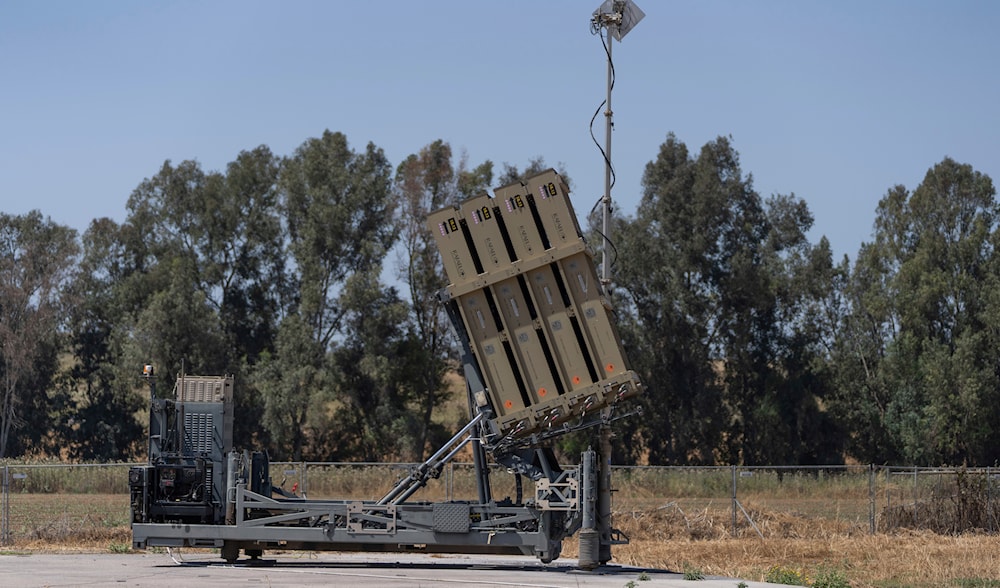Israeli aerial failures manifested in 'Rubik's cube in the sky': WSJ
The Wall Street Journal states that drones are becoming an issue for the occupation, as witnessed by the recent Yemeni strike and the daily failure of intercepting drones by the Lebanese Resistance.
-

"Israel's" Iron Dome anti-missile system stands in place in Sderot on Wednesday, April 17, 2024. (AP)
Hezbollah has launched about 1,000 drones at "Israel" since October 8, The Wall Street Journal reported on Monday.
With this, the Lebanese Resistance group has demonstrated an ability to learn and take advantage of what is dubbed "blind spots" in Israeli defenses by mapping northern occupied Palestine with its surveillance drones, said Sarit Zehavi, founder and president of Alma Research and Education Center, an Israeli think tank, as reported by the WSJ.
This ability is best exemplified in the Hoopoe missions videos provided by the Islamic Resistance.
The Wall Street Journal stated that drones are becoming an issue for the occupation, as they can be small and difficult to detect, and they don't follow predictable paths or release the intense heat from rocket engines that makes it simpler to locate and eliminate missiles.
Moreover, they are cheap and plentiful and are being deployed by Israeli adversaries in increasing numbers and sophistication, as per WSJ.
Since October 7, Hezbollah has shown that it is capable of using drones to attack "Israel" in almost daily exchanges.
Just this month, Hezbollah inaugurated the Iranian Shahed-101 drone in the confrontations in southern Lebanon, a highly-maneuverable aircraft that is notably difficult to detect, sending shockwaves within the Israeli occupation.
"Hezbollah has started using new Iranian Shahed 101 drones for the first time since the beginning of the war," Itay Blumenthal, the military affairs correspondent for the Israeli Kan public broadcaster, revealed. These drones are "very difficult for the Air Force to detect and intercept."
The Islamic Resistance group frequently sends out multiple drones at once, at least one for reconnaissance and another loaded with explosives. Sensitive military equipment has also been struck, including the multimillion-dollar Drone Dome anti-drone system in June and the radar surveillance balloon Sky Dew in May.
In what the WSJ considered an effort to provoke the Israeli military, Hezbollah has been flying surveillance drones over northern "Israel" in recent months, gathering aerial photos and intel of strategically important locations and releasing them as a blunt reminder of "Israel's" vulnerability.
In one day, Hezbollah fired 65 rockets at occupied Palestine, and on the same day, a single drone believed to have flown more than 1,000 miles from Yemen, exploded in the commercial capital Tel Aviv.
The Iron Dome has been a failure at meeting the challenge. Alternatively, jet fighters have been scrambled, an expensive and potentially hazardous measure that exposes pilots to Hezbollah's antiaircraft weapons and forces them to fly low over mountainous terrain.
Read more: Hezbollah drones pose huge challenge to Israeli detection systems
Ariel Frisch, deputy security officer of Kiryat Shmona, an Israeli settlement hit with at least six explosive drones since Oct. 7, said, “UAVs have turned into the main threat in terms of our ability to deal with it, because the army right now has no means of prevention except using F-16s,” adding, “We are very, very worried about it.”
"Israel's" susceptibility to unmanned aerial vehicles is indicative of the difficulties it would encounter in a full-scale war with Hezbollah and the inability to ever feel certain in its abilities to neutralize threats.
A report by the Israeli ALMA Research Center in 2021 indicated that Hezbollah possesses around 2,000 drones, some of which are advanced and locally manufactured. The report added that Hezbollah had been deploying drones, such as the Shahed-129, Mohajer, and Karrar, since before the 2006 July War.
The Islamic Resistance in Lebanon has a comprehensive system of military capabilities, particularly in terms of aerial weaponry represented by drones. Hezbollah's arsenal includes reconnaissance, attack, and offensive drones.
Pilots who want to shoot down drones with a jet must find difficult-to-detect devices and tell them apart from friendly drones, other warplanes, and private aircraft. According to an Israeli Air Force pilot, the drones have low heat signatures, so the aircraft must approach them from behind in order for the heat-seeking missiles to engage.
An Air Force official involved in aerial threat identification compared drones and jets, civilian aircraft, and birds to "a Rubik's Cube in the sky."
Hezbollah Secretary General Sayyed Hassan Nasrallah revealed about two years ago that the Resistance group "has been manufacturing drones for years," affirming that "the Resistance decided to operationalize the existing air defense systems years ago."
Lebanese and Iranian drones have become a major concern for the Israeli occupation, emerging as an effective weapon in the Islamic Resistance's operations against various Israeli targets, including sites, headquarters, surveillance stations, and troops in the depths of northern occupied Palestine.

 5 Min Read
5 Min Read








